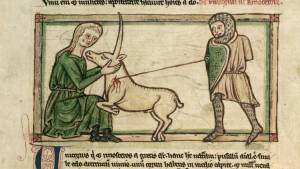In our house, we are very serious about unicorns. Our five-year-old daughter recently got serious enough that she demanded I wear a unicorn costume to her unicorn-themed birthday party. I refused and was on the brink of being uninvited, but in the end she showed mercy and allowed me entrance to the party I paid for, in my own home.
At the party, we snacked on unicorn cupcakes, pinned-the-horn-on-the-unicorn, and played with unicorn balloons. A few of us may have even capitulated enough to her whimsy to wear a unicorn horn on our heads. My older two daughters are tweens but they both still love unicorns, too. Last year for Christmas, one of them received a unicorn ring-toss game that we had a ton of fun playing.
I suspect that my house is like many other households right now. We are inundated with unicorn clothing, binders, stickers, and books. I preached a homily about unicorns to my parish schoolchildren the other day, and when I asked how many of them had on a unicorn-themed item of clothing at that very moment, a shocking number of them raised their hands.
Because unicorns are mythological, fantastical creatures and are often portrayed in bright, confident colors, it seems to me that many adults who like them think of them as symbols of individuality and freedom. Being a unicorn is to be yourself, to stand out and not worry what anybody else thinks about you. It’s a form of escapism. Children, on the other hand, just think unicorns are really cool. They think unicorns would be fun to hang out with.
Either way, there is, in fact, a hidden meaning to the symbol of the unicorn, and a long history to how they came to be so prominent. They actually make an appearance in an old English translation of the Bible where in Psalms 91 it says, “My horn shall be exalted like that of the unicorn.” You see, before unicorns were cute little ponies, they were strong and powerful.
Unicorns, of course, are real. Well, sort of. A Roman historian named Pliny the Elder wrote a book in which he described them. He says it’s “A very fierce animal … which has the head of the stag, the feet of the elephant, and the tail of the boar, while the rest of the body is like that of the horse; it makes a deep lowing noise, and has a single black horn, which projects from the middle of its forehead, two cubits in length. This animal, it is said, cannot be taken alive.”
We’re not quite sure what he was talking about, it may have been rumors of the mighty rhinoceros, or the unicorn may have been based on the narwhal horns that occasionally wash up on a beach somewhere, but all the rumors of powerful creatures in distant lands, as imaginative as they became, were based in fact. The rumors were impossible to confirm because unicorns were so strong that, as Pliny said, they were impossible to capture — unless you knew the secret.
But here is how to capture a unicorn: According to a medieval collection of religious lore called the Physiologus, there is a specific strategy that needs to be used. First, you have to clothe a chaste young lady in a beautiful dress with beautiful jewelry, then you seat her in a solitary place in the forest where you suspect a unicorn lives. When the unicorn finds her, all his strength will turn to gentleness. He will desire to protect and comfort her because she is all alone in the forest. He will lay his head gently in her lap and fall asleep. Then you sneak up and capture him, take him to the king’s palace, and receive much treasure in payment for him.
The symbolism of the unicorn was highly developed by the Catholic Church. There is even artwork in churches depicting unicorns. The chaste lady represents the Blessed Virgin Mary, and the unicorn is Christ. He is captured because even though he is mighty, he is gentle and kind with his mother. He allows himself to be captured for her sake.
When I told my parish children this story about unicorns – it’s often one that is told around the Annunciation on March 25 – they seemed more engaged than usual. More than anything, I want them to learn from the story that strength is found in gentleness and love, that people who are strong aren’t afraid to make a commitment or a sacrifice on behalf of another person. I told the children that, each time they put on their unicorn shirts, to remember that love is mightier than all the creatures of the forest and more powerful than every hunter who may try to capture it.

Read more:
Why are there unicorns in the Bible?

Read more:
7 Classics you should read to your children before they are seven

